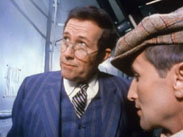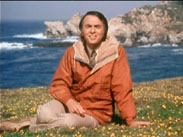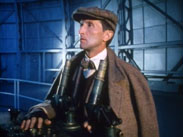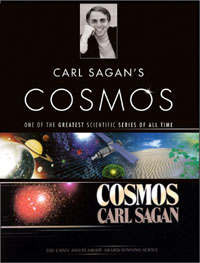Doppler Distanced from the Observer?
The prelude to this recreation is all about the concept of Doppler Shifts, which are
introduced by examining the shifting pitch of the sound of a passing locomotive train horn.
One way of understanding this, which is perhaps the easiest way, is to think of the speed of
an approaching train being added to the speed of the sound on its way to the human ear,
and then later, the speed of the receding train being subtracted from the speed
of the sound. When that human ear then analyzes the waveform of the sound,
it really can't tell the difference between the speed of the sound and its frequency.
The ear makes a perfectly natural mistaken assumption - that the speed is just fine,
but the frequency has changed, therefore the pitch of the horn is off.
We human beings are smart enough though, to think beyond our raw perception
and realize when something else might actually be going on.
But new ground was broken in the 1920's when astronomers theorized that the LIGHT
from distant galaxies might also be experiencing a Doppler Shift. Notice the date,
the 1920's - Einstein's two Theories of Relativity were only just gaining traction
in the English-speaking world. To what extent might the phenomenon of Doppler Shifts
from the light of the galaxies have been created in a pre-Relativity mindset,
and then have had to modify itself to accommodate Einstein's theories?
If you think about the two ideas as they are presented here in Cosmos,
they really don't seem to fit together very well at all.
Relativity itself was an attempt to allow two contradictory ideas to support each other,
one of those being Einstein's interpretation of Maxwell's law of propagation of light.
If we express that relevant bit "through the front door",
light in a vacuum somehow magically always travels at the speed "c" relative to the observer.
To express this same thing "through the back door", as Sagan expressed it in episode 8,
thou shalt not add the speed of the source of a light to the speed
of the light as it travels. Gee, we can't add velocities for light
the same way we did for sound, or so Relativity tells us. Does that not bugger up
the entire concept of galactic Doppler Shifts?
As I understand the galactic Doppler Shift example presented here in this episode,
there is perhaps one additional assumption which is not being highlighted. And that
is that when we look at the light of the distant galaxy and we see two dark lines
of some frequencies that are missing from its colour spectrum, we ASSUME that we
know what that REALLY is supposed to be. Oh yeah, those lines are the signature of
calcium deposits, and they should be over here at this part of the spectrum,
but something has red-shifted all the frequencies over to this other part of the spectrum,
so understandably, the colours are off here, the same way that the pitch of the train horn
was off. But if somehow we are wrong about what these two lines REALLY represent,
if they're not due to calcium but something else, it's one more way that the house of cards
of our understanding of the universe might come crashing down. Though I might
throw up a word of caution there, I don't actually believe this is a bad
assumption for us to make at this point.
At any rate, it seems that we can take these "wrong" colours, this frequency shift,
and mathematically re-interpret it such that it is the right frequency
at the wrong velocity, and from that get an idea of how fast the
galaxy may be moving towards us or away from us.
I don't suppose it should matter if light travels to us observers at "c" relative
to ourselves, or at "c" relative to the source... in terms of reversing the math
to figure out how fast the source is traveling relative to us. But in terms
of grasping the concept of what's going on, there is a significant difference.
Einstein's Relativity seems poised to remove the possibility that the fundamental
misinterpretation of velocity for frequency happens at the eyeball, or telescope,
or photographic plate, during perception. Instead, it insists that the
"misinterpretation" is happening out at the distant galaxy, at the point of light emission.
It reminds me of a classic old ego-flip that science had to
correct centuries ago, to go from believing that the universe revolved
around us, to the idea that we are spinning regularly within the universe.
How does a galaxy emit its
spectrum of light at "c" relative to us with the frequency being just that bit
off? Conceptually, it's much easier to grasp a predictable, calculatable
misinterpretation in an eye or instrument that assumes light should
arrive at speed "c", rather than a galaxy that emits false frequencies
at whatever varying speeds are necessary for any observers that may happen
to be looking. In other words, it's easier to believe in the Doppler Shift phenomenon
for light without Relativity than it is with Relativity.
Incidentally, astronomers seem to have at least two separate
ways of calculating galactic red-shift, one based on the math of Newton & Galileo,
and a "Relativistic" one based on Einstein. Do we have any reliable way
of verifying which one (if either) may really be right? Would the difference between
the two make fundamental differences in our interpretation of cosmology as a whole,
in how the universe began, how it might end, whether or not its life is cyclical,
whether or not dark matter or dark energy are required to make it work?
At any rate, after having demonstrated how we came to believe we know
how fast the galaxies are all moving, and in which directions,
"Cosmos" makes a quick leap from this evidence to the concept
of the Big Bang. Fair enough. In actuality, as might be considered
typical in science, the ideas didn't flow along quite so easily and
smoothly. Much more depth on that particular part of the story
can be found in the 1st season special episode of "The Universe" entitled
"Beyond the Big Bang" - a worthwhile
eye-opening companion piece to this episode.
Flatland and 4D Space Curves
The next section of the episode retells the classic story of Flatland,
while mentioning its original author. Though this is perhaps realized
more memorably in extended editions of
"What the Bleep Do We Know",
Cosmos is unique in using this as a springboard for tackling
the more interesting idea of a 4th spatial dimension.
Thus we get to see both how a 3D cube can cast a shadow into a 2D world,
and how a theoretical 4D cube, or tesseract, can cast a "shadow"
into our 3D world - that shadow being realized as a complete 3D sculpture.
This is a fascinating idea, but the actual 3D tesseract "shadow" doesn't
really seem to be a very convincing representation of what it is
supposed to be. The abstract idea itself was easier grasp. Still,
it's nice that someone made this attempt.
But... holy cow, check out
Wikipedia's page for the Tesseract,
because this 3D shadow gets much more convincing when it is put in motion,
and the 4D cube rotates before your eyes. Whoa, what are we looking at here?
Now THAT will blow your mind!
We then move on to apply this idea to a theoretical curvature in space,
which is cool. Sadly the graphics here, as in similar sections
in episode 9, are only cartoonish and a bit disappointing. It seems
either time or the budget, perhaps both, had run out. Oh well.
It still seems to be rather neat in the end anyway.
It's additionally interesting to note how this whole Flatland / 4D / Space Curvature
sequence seems to be a reflection of the sequence of similar ideas in Einstein's
1920 book about Relativity, specifically where he avoids math and sticks to
conceptual ideas to prepare the reader for the leap from Special Relativity
to General Relativity. The big difference there may be the idea that he wants
to twist time mathematically until it can be represented as if it were a fourth
dimension of space, which apparently has some purely mathematical benefit.
Whether or not that process is accurate or valid may remain a separate point entirely.
For my tastes, I find that Cosmos episode 10 here has a far cleaner and more
tasteful interpretation of the core ideas, where that 4th dimension can be
its own spatial thing, and not some twisted re-interpretation of time. Good one!
Mythic Cosmology from India
Our next segment takes us to India, where Sagan explores Hindu culture, customs,
and - most significantly - religious myths. In particular, many of these myths
reflect modern cosmological thinking, and at the correct timescale of billions
of years as well.
I tend to favour the concept supported by both these Hindu myths and the
scientific models of a Big Bang followed by a Big Crunch, where the universe
eventually draws itself back together through gravity to "destroy itself",
or to transform to the next phase, which could well be the next Big Bang
creating the next universe. And on and on, in a cycle. Sagan takes his time
with this section, pouring over many more fascinating details of the idea
from these various sources and disciplines.
Sagan seems to want to resist ideas of God creating the Universe in his
presentation, believing he's well debunked it by saying that it implies an
infinite regress of creators creating creators, and what came before each of them?
I think he's missed something fundamental - the idea of intelligence as a base
unit in the fabric of the universe, more fundamental than the tiniest
subatomic particle, string, quark, or meson. Is it not primarily because
he assumes intelligence had to arise out of random combinations of atoms
that he still searches for something unintelligent to exist before intelligence?
If the atoms arose out of the intelligence instead, intelligence can remain the
beginning, full stop, nothing prior. Me, I don't need to imbue that intelligence
with a persona, and an ego, or try to think of it as a "king on high"...
those things CAN be said to have arisen out of the atoms. But it is kind of funny
to hear how often Sagan interjects the phrase "completely by accident" into
whatever he's describing. Really, "by accident" just means that someone
hasn't been able to fully see the mechanism for a process yet. He could
leave out his "accidents" and have a cleaner presentation, even though
it's still quite good anyway.
Finally, we get a few more notes from radio-telescopes and satellite photos,
bringing our understanding of the phenomena up to 1992 levels. Of course,
there is a lot of talk these days about theories such as
"The Big Freeze" and "The Big Rip", which seem to have gained more traction
than "The Big Crunch". But when it comes to interpreting the large swath
of new information we are just learning how to gather, I'm reminded of
what was said in episode 7 about how Huygens attempted to estimate
the distance to the star Sirius. His assumption that it was of the same
size and composition as our own sun threw his otherwise reasonable calculations
way off. Are we doing the same today with Type 1a Supernovas? Or with Cepheid Variables?
Or with the notion that we are looking at a calcium spectrographic "fingerprint"
in the light from another galaxy, only it's been red-shifted from where we all-knowingly think
it really should be?
Might this not throw off our own estimates of the sizes, distances, and masses of
many of the deep universal objects? How much of this are we really
getting correct? I think if Mankind could add to his knowledge database
some observations made from within solar systems other than our own,
it would trigger a grand and much-needed self-correction of many astronomical ideas,
and/or be a critical corroborating step. How far in our future might such
research become a practical reality?
In the end, this is a really nice episode. In fact, it would be difficult
to really absorb all the grand ideas layered into it in just one go.
This is an episode where one can pick out new ideas on multiple viewings,
and it is definitely one of the better ones on Cosmos. Excellent!
|













